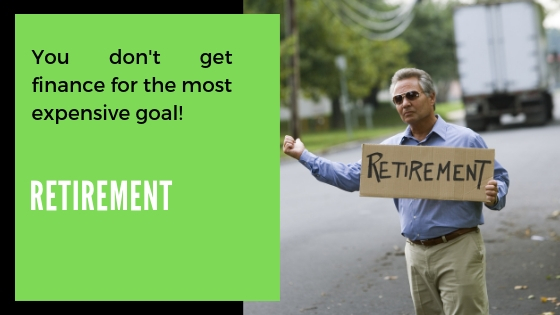

What’s your retirement plan?
Let’s play a small game.
Pick the odd one out:
Home
Vacation
Car
Retirement
Education
Dream Wedding
Could you figure the odd one out?
It is retirement.You can take a loan for everything else but retirement. Hence, planning for retirement should be on everyone’s top of mind. Starting to plan for retirement as early as possible is the best way as you don’t have to stress about investing a considerable sum of money in the later part of your life.
Everyone’s retirement plan and needs are different. The size of the retirement corpus will not just depend on how much you save and invest, but also how you want to spend after retirement. If you're going to live a frugal life, you may need to accumulate less than someone who wants to pursue expensive hobbies or go on world tours after retirement.
As retirement is a long term goal, knowing how much to invest in the different phases of your life and how much you should have invested until now are crucial steps in retirement planning. There are various ways to find out how much you should have saved for retirement. One method is the 80% rule. According to this rule, you need to have 80% of your annual salary before retirement for each year. According to another method, you should have saved 50% of your annual income towards retirement by the time you hit 30, two times your salary by 40 years and four times by 50 years.
While these methods can help us to have an idea on how much we need to accumulate as per our life stage, a better way to do so would be to invest a proportion of the monthly income consistently.
The FOMO generation and millennials
For the people who are fresh graduates, may feel that retirement is in the distant past. Today, young people believe in having experiences and have a ‘You Live Only Once’ attitude. Many don’t want to invest for their retirement as they think it is a waste of money and the entire invested amount will go down the gutters if they don’t survive till 60. But what if you live?
People in the mid-20s to early 30s can start accumulating their retirement corpus by investing 5% of the monthly income regularly. Investors can start investing regularly in a midcap fund or ELSS funds through Systematic Investment Plan(SIP). Equity funds are recommended as they give higher returns in the long run. As investors in this stage have just started working, their earning potential may be limited. And if they are staying alone in a big city, essential expenses such as rent and food constitute a large chunk of their income. Hence, taking baby steps will go a long way in accumulating the desired retirement corpus.
The middle-aged people
In the late 30s and 40s, the earning capacity of individuals increases. By this time, many individuals would have stopped job switching. They are also likely to have one or two kids. While their earning capacity increases, so does their burden of financial responsibilities. Whether it is taking care of their children’s education, paying loan EMIs and insurance premiums, and vacations, all these responsibilities constitute a large proportion of their income. Hence, individuals who are in this stage should aim to save at least 10% of their income for retirement. Also, one has to keep in mind to top up their investment amount as and when they get an increment.
Almost near retirement
In this stage, many of the responsibilities would have been over. It is the time that your kids are most likely to be in college, and they are on the verse to becoming financially independent. Loans are most likely to be out of the picture by this time. With the decrease in responsibilities, you can increase your investment to 15% of your income or more. As an individual approaches retirement, say 55 years, investors can shift their investments to a debt fund. The objective of the debt funds is to protect capital. They can continue their regular investments in the debt fund. This will help individuals to set up a systematic withdrawal plan (SWP) in the debt fund and redeem a monthly sum of money to take care of the day-to-day expenses after retirement.
To summarise, one can gradually increase their investment in retirement. The key here is to start investing as early as possible.
AwealthZ Finserve LLP
E-871, 2nd Floor, Behind Jagdamba
Tower Amrapali Circle, Vaishali
Nagar Jaipur - 302021 (Rajasthan)
+91 9828511664
Copyright © AwealthZ Finserve LLP. All rights reserved. |
Risk Factors – Investments in Mutual Funds are subject to Market Risks. Read all scheme related documents carefully before investing. Mutual Fund Schemes do not assure or guarantee any returns. Past performances of any Mutual Fund Scheme may or may not be sustained in future. There is no guarantee that the investment objective of any suggested scheme shall be achieved. All existing and prospective investors are advised to check and evaluate the Exit loads and other cost structure (TER) applicable at the time of making the investment before finalizing on any investment decision for Mutual Funds schemes. We deal in Regular Plans only for Mutual Fund Schemes and earn a Trailing Commission on client investments. Disclosure For Commission earnings is made to clients at the time of investments.
AMFI Registered Mutual Fund Distributor – ARN-243510 | Date of initial registration ARN – 06-Apr-2022 | Current validity of ARN – 05-Apr-2028
Important Links | Disclaimer | Disclosure | SID/SAI/KIM | Code of Conduct | SEBI Circulars | AMFI Risk Factors